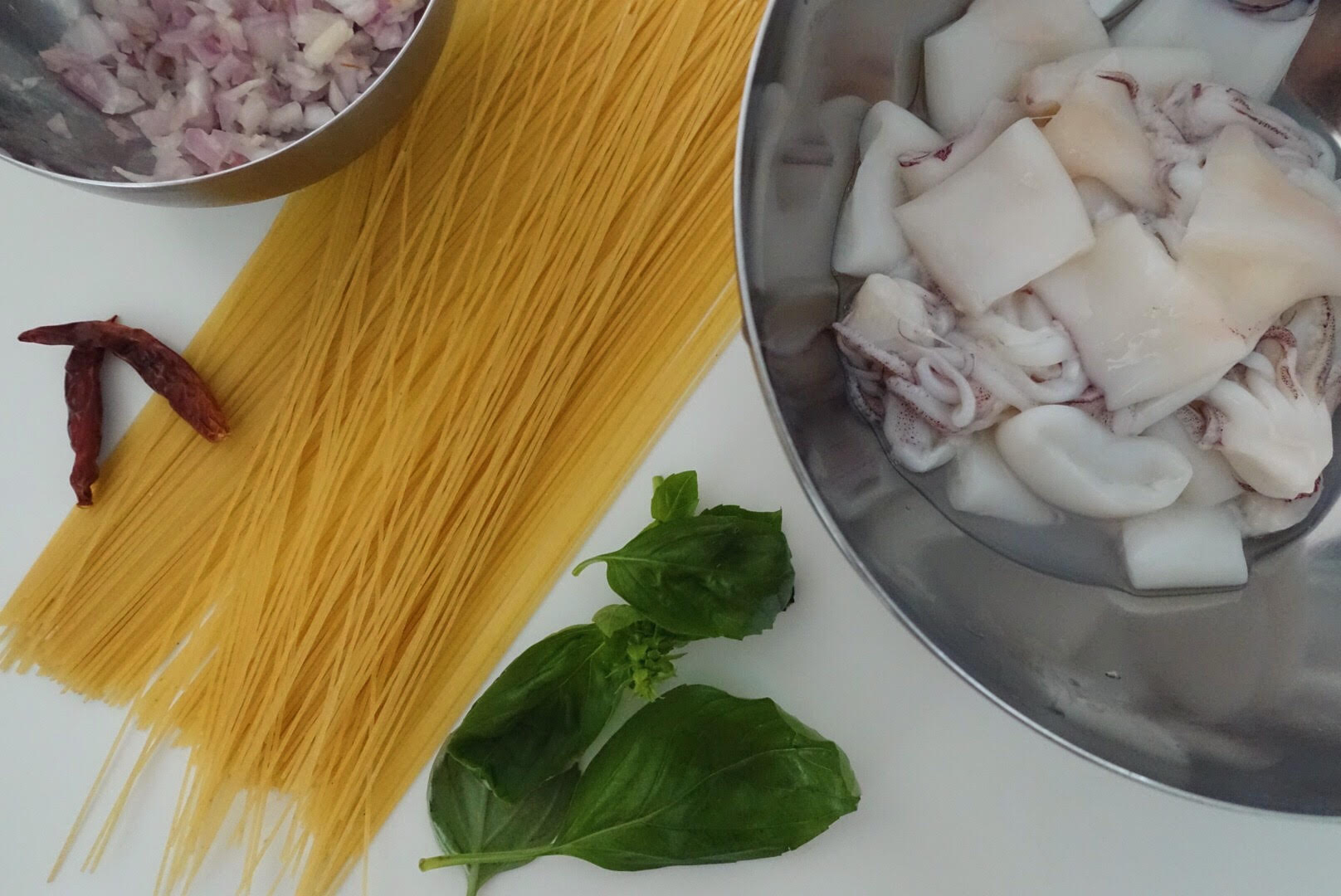Preparation time: 10 minutes
Cooking time: 10 minutes
Serves: 2 portions
Ingredients
- 2 serving portions of dry angel hair pasta, or spaghetti, whichever you prefer (a 1-inch diameter bunch of dry pasta should give you 1 portion)
- ½ tablespoon of olive oil
- ½ an onion (chopped finely/minced)
- 5 dried red chilies (rinsed and drained completely; use half of the quantity if your dried chilies are longer in size)
- 4-5 big squids (cleaned, peeled, deveined, cut into 2.5 to 3-inch lengths and marinated in 1 teaspoon of sugar)
- 2 Spring onions (chopped, reserve ¾ for cooking and ¼ for garnishing) OR fresh basil
#htNOTE: If your tolerance to spice isn’t great, cut along the length of the dried chilli and remove the seeds.
Kung Pao Sauce
- 4 tablespoons of light soy sauce
- 1 tablespoon of sweet thick soy sauce (I used ABC Kecap Manis for this)
- 5 tablespoons of water
- 2 tablespoons of oyster sauce
- 3 dashes of white pepper
- 2 dashes of garlic powder
- 1 tablespoon of Chinese black vinegar (preferred) or rice vinegar or Apple Cider vinegar
- ½ teaspoon of sugar (add a bit more if you prefer it to be sweeter)
- 1 tablespoon of Japanese mirin (optional)
#htNOTE: Dip your finger into the sauce (after thoroughly mixing) to taste and see if you’re okay with the taste. If you’re like me and prefer it to be a tad sweeter, add an extra ¼ to ½ tablespoon of sugar according to your preference.
Cooking
- Mix the Kung Pao sauce ingredients in a bowl and set aside.
- To cook the pasta, pick a roomy pot that gives the pasta plenty of space to move; and fill it up with 2-3 litres of cold/room temperature water. Using plenty of water helps to prevent the pasta from sticking together by quickly washing away the exuded starch.
- Bring the water to a full, rolling boil. When the water has come to a full boil, add about 12 - 16 tablespoons of kosher (coarse) salt, or until the water tastes like "sea water". Be generous with the salt. This may seem like a lot, but it is necessary for getting the pasta properly seasoned. Plus, most of the salt drains off with the water. Nevertheless, if you are on a sodium restricted diet, please follow your doctor’s orders before adding salt. Do NOT add oil of any kind. Oil has the unwanted effect of coating the pasta so the sauce will not stick.
- Add the pasta, all at once, to the boiling salted water, and keep the heat high to bring the water back to the boil as quickly as possible.
- Keep stirring the pasta until they are just flexible but still quite firm (usually about a 1/3 of the normal cooking time).
- Drain immediately, and rince in ice cold water, then drain again and set aside.
- Meantime, clean and dry your wok thoroughly, and heat it over high flame until it starts to smoke.
- Put the olive oil into the wok and add the minced onions first. Stir-fry for a few seconds before adding the dried red chilies. Stir-fry until you smell the spicy aroma from the dried red chilies.
- Add in the Kung Pao sauce mix then immediately bring the heat down a notch.
- Add in the squid and stir fry for less than a minute (once the edges start curling in) and dish out the squid immediately so that it doesn’t overcook. Set aside. At this point your squid should be almost but not entirely cooked.
- Add in the 1/3 cooked pasta and mix into the sauce using a fork (this will also help to separate the pasta in the sauce). Keep stiring/mixing until the sauce is absorbed into the pasta, or until the pasta is "al dente" (it should have a slight resistance or chewy texture when biting into it, but it should also not be soft, overdone, or have a hard center).
- Test, it should be tasty on its own. Once almost done, add the ¾ portion of spring onions (or fresh basil) and squid, and mix until squid is cooked.
- Dish out and garnish with the ¼ portion of spring onions. Serve with a dash of black pepper if desired.
Reference: http://whatscookingamerica.net/Pasta_Rice_Main/pasta.htm
Use the comment box below if you have any questions and do let us know how your Kung Pao Squid Pasta turns out. Happy experimenting fellow foodies! :-D






















